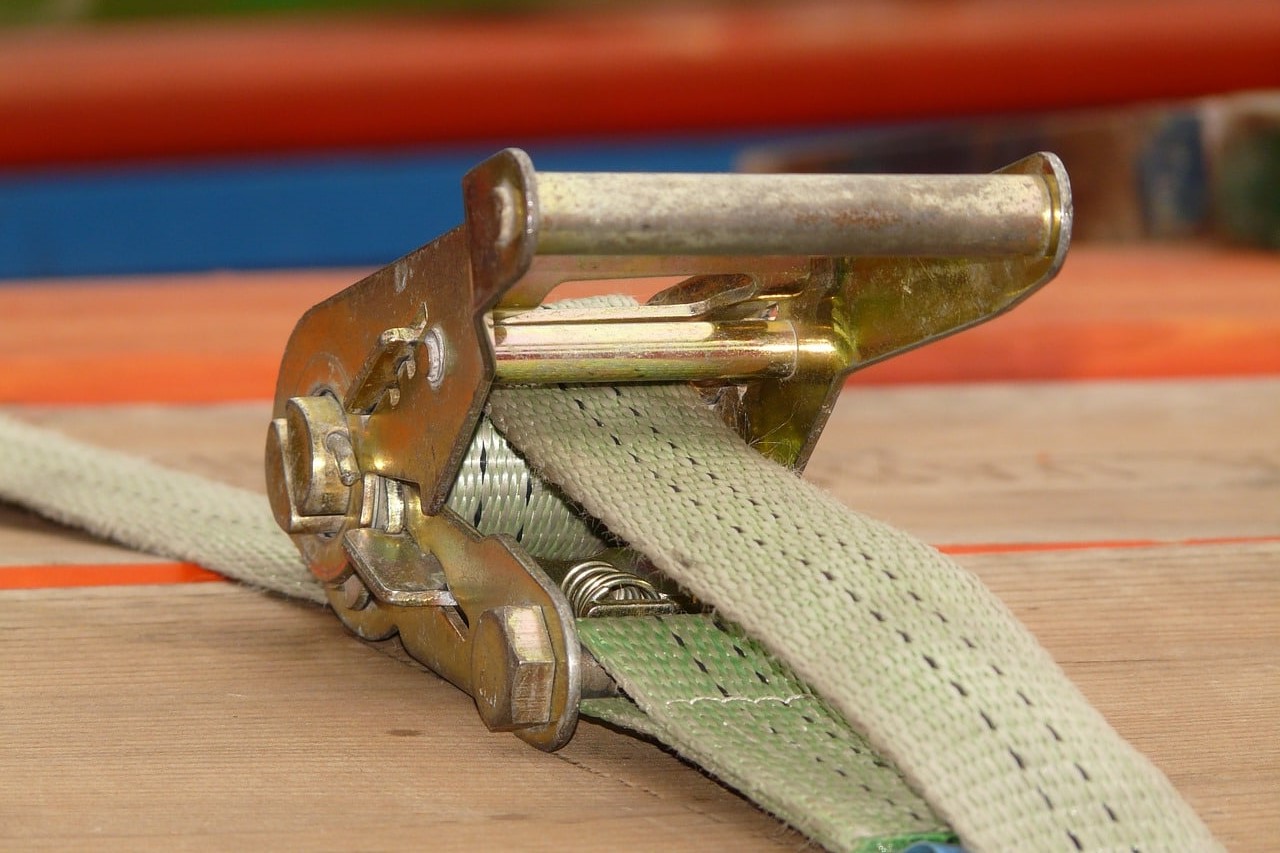Home>Home and Garden>How To Thread A Ratchet Strap


Home and Garden
How To Thread A Ratchet Strap
Published: February 29, 2024
Learn how to properly thread a ratchet strap for securing your items at home and garden. Follow our step-by-step guide for safe and effective use.
(Many of the links in this article redirect to a specific reviewed product. Your purchase of these products through affiliate links helps to generate commission for Noodls.com, at no extra cost. Learn more)
Table of Contents
Introduction
Ratchet straps are indispensable tools for securing cargo during transportation, whether you're moving furniture, hauling equipment, or transporting goods. These versatile straps provide a reliable and adjustable means of fastening items, ensuring they remain stable and secure throughout the journey. Understanding how to properly thread a ratchet strap is essential for anyone involved in loading and transporting goods, as it ensures the safety of the cargo and other road users.
In this comprehensive guide, we will walk you through the step-by-step process of threading a ratchet strap, covering each essential detail to help you master this fundamental skill. By following these instructions, you'll gain the confidence and expertise needed to securely fasten your cargo, preventing any potential shifting or damage during transit.
Whether you're a seasoned professional or a novice in the realm of cargo transportation, mastering the art of threading a ratchet strap is a valuable skill that can save time, effort, and potential headaches. So, let's dive into the intricacies of ratchet straps and learn how to effectively utilize this essential tool for securing your valuable cargo.
Read more: How To Use Wrist Straps
Understanding the Components of a Ratchet Strap
Before delving into the process of threading a ratchet strap, it's crucial to familiarize yourself with its key components. A typical ratchet strap comprises several essential elements that work in unison to secure cargo effectively. Understanding these components is fundamental to ensuring the proper utilization and functionality of the strap.
-
Webbing: The webbing forms the foundation of the ratchet strap and is typically made of durable materials such as polyester or nylon. This robust fabric provides the strength and resilience needed to withstand the tension and pressure exerted during the securing process.
-
Ratchet Buckle: The ratchet buckle serves as the primary mechanism for tightening and releasing the strap. It consists of a handle, a ratcheting mechanism, and a release lever. The handle is used to apply tension to the webbing, while the ratcheting mechanism locks the strap in place, preventing it from loosening during transit. The release lever allows for quick and efficient unfastening of the strap when required.
-
Hooks or End Fittings: At each end of the ratchet strap, you'll find hooks or end fittings that attach to anchor points or anchor rails on the vehicle or cargo bed. These hooks are designed to securely grasp the anchor points, providing a stable connection for the strap.
-
Tensioning Device: Some ratchet straps feature a tensioning device, which may be a simple hand-operated crank or a lever that facilitates the initial tightening of the strap before engaging the ratchet buckle. This component streamlines the process of applying tension to the webbing, ensuring a secure and snug fit around the cargo.
By understanding the function and significance of each component, you'll be better equipped to navigate the process of threading a ratchet strap with confidence and precision. With this foundational knowledge in place, you're ready to proceed to the practical steps of effectively utilizing a ratchet strap to secure your cargo.
Step 1: Feed the Strap Through the Ratchet
The first step in effectively utilizing a ratchet strap is to feed the strap through the ratchet mechanism. This process sets the stage for securing the cargo with precision and reliability. To begin, ensure that the ratchet handle is in the fully open position, allowing the strap to be easily threaded through the mechanism.
-
Positioning the Webbing: Start by positioning the loose end of the webbing over the ratchet spool, ensuring that the webbing lies flat and untwisted. This initial placement is crucial for maintaining the integrity of the strap and preventing any potential entanglement within the ratchet mechanism.
-
Engaging the Ratchet Spool: Once the webbing is positioned over the ratchet spool, guide it through the slot in the spool, ensuring a snug fit without any twists or tangles. As you pull the webbing through, maintain a firm grip to prevent any slack from forming, which could compromise the effectiveness of the strap.
-
Aligning the Webbing: As the webbing emerges from the ratchet spool, ensure that it remains flat and aligned, without any folds or creases. This alignment is essential for optimizing the grip and tensioning capabilities of the ratchet strap, as any irregularities in the webbing's positioning could lead to instability during transit.
-
Securing the Initial Position: Once the webbing has been successfully fed through the ratchet mechanism, secure its initial position by ensuring that it is firmly engaged with the spool and free from any obstructions. This preparatory step sets the foundation for the subsequent tightening and securing of the strap, laying the groundwork for a reliable and robust cargo restraint system.
By meticulously following these steps and paying attention to the details of feeding the strap through the ratchet, you establish a solid starting point for effectively utilizing the ratchet strap to secure your cargo. With the webbing correctly positioned and engaged within the ratchet mechanism, you are now ready to proceed to the next crucial phase of tightening the strap to achieve optimal security and stability for your transported goods.
Step 2: Pull the Strap Tight
With the webbing successfully threaded through the ratchet mechanism, the next pivotal step in effectively utilizing a ratchet strap is to pull the strap tight, applying the necessary tension to secure the cargo with precision and reliability. This phase of the process is instrumental in ensuring that the transported goods remain stable and immovable throughout the journey, safeguarding against potential shifting or damage.
To pull the strap tight, begin by firmly grasping the loose end of the webbing and applying steady pressure to initiate the tensioning process. Depending on the specific design of the ratchet strap, you may utilize a tensioning device, such as a hand-operated crank or lever, to facilitate the initial tightening of the strap before engaging the ratchet buckle. This device streamlines the process of applying tension to the webbing, allowing for a controlled and uniform tightening of the strap.
As you pull the strap tight, maintain a balanced and consistent application of force, ensuring that the tension is distributed evenly across the webbing. This uniform tightening is essential for achieving a secure and stable hold on the cargo, minimizing the risk of any potential slippage or movement during transit. Additionally, be mindful of maintaining a straight and aligned orientation of the webbing, preventing any twisting or overlapping that could compromise the effectiveness of the strap.
As the tension increases, monitor the positioning of the webbing to verify that it remains securely engaged with the ratchet spool and free from any entanglements or obstructions. This vigilance ensures that the webbing is effectively gripped by the ratchet mechanism, allowing for the seamless transition to the subsequent phase of securing the strap in place.
By diligently pulling the strap tight and applying the necessary tension, you establish a robust and reliable restraint system for your cargo, laying the groundwork for a safe and secure transportation experience. This meticulous attention to tightening the strap sets the stage for the final steps of securing the strap in place and releasing the ratchet, culminating in the successful utilization of the ratchet strap to safeguard your valuable cargo.
Step 3: Secure the Strap in Place
After successfully tightening the ratchet strap and applying the necessary tension to secure the cargo, the next critical step is to secure the strap in place, ensuring that it remains steadfast and immovable throughout the transportation process. This phase of the process is pivotal for fortifying the restraint system and preventing any potential slippage or loosening of the strap, thereby safeguarding the transported goods against shifting or damage.
To secure the strap in place, begin by firmly grasping the ratchet handle and engaging the ratcheting mechanism. This action initiates the process of locking the strap in position, preventing any slack or loosening that could compromise the integrity of the cargo restraint system. As you operate the ratchet handle, ensure a smooth and controlled motion, allowing the mechanism to incrementally tighten and secure the webbing with precision.
As the ratchet mechanism engages, you will feel the resistance increase, indicating that the strap is being securely locked in place. Continue operating the ratchet handle until the webbing is firmly tensioned and immobilized, providing a stable and reliable hold on the cargo. It is essential to exert sufficient force to ensure a snug fit without over-tightening, as excessive tension could potentially strain the webbing or the ratchet mechanism.
Throughout the process of securing the strap in place, maintain a vigilant eye on the alignment and positioning of the webbing, verifying that it remains flat, untwisted, and securely engaged with the ratchet spool. This attention to detail ensures that the strap is effectively gripped and immobilized by the ratchet mechanism, minimizing the risk of any potential slippage or instability during transit.
Once the strap is securely locked in place, double-check the entire length of the webbing to confirm that it is uniformly tensioned and free from any irregularities. This comprehensive assessment guarantees that the cargo restraint system is optimally configured, providing a robust and reliable safeguard for the transported goods.
By meticulously securing the strap in place, you establish a resilient and dependable cargo restraint system, effectively utilizing the ratchet strap to ensure the safety and stability of your valuable cargo. This phase sets the stage for the final step of releasing the ratchet, culminating in the successful completion of the threading process and the establishment of a secure and reliable cargo transportation solution.
Read more: How To Use Lifting Straps
Step 4: Release the Ratchet
Releasing the ratchet is the final step in the process of effectively utilizing a ratchet strap to secure cargo. This phase involves disengaging the ratchet mechanism to release the tension on the strap, allowing for the efficient unfastening and removal of the strap from the secured cargo. While seemingly straightforward, the proper release of the ratchet is crucial for ensuring the safe and efficient handling of the strap, as well as the cargo it has been securing.
To release the ratchet, begin by locating the release lever, typically positioned near the ratchet handle. This lever serves as the mechanism for disengaging the ratchet, allowing for the controlled and gradual release of tension from the strap. With a firm grip on the ratchet handle, maneuver the release lever in the designated direction, typically in an upward or outward motion, depending on the specific design of the ratchet mechanism.
As the release lever is operated, you will feel the tension gradually dissipate from the strap, indicating the successful disengagement of the ratchet mechanism. It is essential to maintain a controlled and deliberate motion when releasing the ratchet, ensuring that the tension is released uniformly and without any abrupt movements that could potentially compromise the safety of the process.
As the tension is released, carefully unwind the webbing from the ratchet spool, ensuring that it flows smoothly and without any resistance. This meticulous approach prevents any potential snags or entanglements, allowing for the seamless removal of the strap from the secured cargo. As you unwind the webbing, maintain a firm grip to guide its controlled release, preventing any sudden movements that could lead to uncontrolled unwinding or potential hazards.
Once the webbing has been fully released from the ratchet spool, carefully disengage the hooks or end fittings from the anchor points or anchor rails, ensuring that the strap is completely free from the secured cargo. This deliberate and methodical approach guarantees the safe and efficient removal of the strap, minimizing the risk of any potential damage to the cargo or the surrounding environment.
By effectively releasing the ratchet and removing the strap with precision and care, you conclude the process of threading a ratchet strap, successfully securing and transporting your valuable cargo. This final step ensures that the ratchet strap can be efficiently utilized for future cargo transportation needs, providing a reliable and adaptable solution for securing goods during transit.
Conclusion
Mastering the art of threading a ratchet strap is a fundamental skill for anyone involved in cargo transportation. From securing furniture during a move to fastening equipment for transport, the ability to effectively utilize a ratchet strap ensures the safety and stability of the cargo, as well as the peace of mind of the transporter. By understanding the components of a ratchet strap and following the step-by-step process outlined in this guide, individuals can confidently and proficiently secure their valuable goods for transit.
The process begins with feeding the strap through the ratchet, ensuring that the webbing is positioned and aligned correctly to facilitate a smooth and effective threading. Pulling the strap tight is the next crucial step, requiring a balanced application of force to achieve uniform tension and stability. Securing the strap in place follows, where the ratchet mechanism is engaged to lock the webbing in position, providing a reliable and steadfast hold on the cargo. Finally, releasing the ratchet marks the conclusion of the process, allowing for the safe and efficient removal of the strap from the secured cargo.
By meticulously following these steps, individuals can establish a robust and reliable cargo restraint system, safeguarding their goods against potential shifting, damage, or loss during transit. The attention to detail in each phase of the process ensures that the ratchet strap is effectively utilized, providing a secure and adaptable solution for a wide range of cargo transportation needs.
In conclusion, mastering the art of threading a ratchet strap empowers individuals to take control of the safety and security of their transported goods. Whether for personal or professional use, the ability to effectively utilize a ratchet strap is a valuable skill that streamlines the process of cargo transportation, ensuring that items reach their destination in optimal condition. With the knowledge and expertise gained from this guide, individuals can approach the task of securing cargo with confidence and precision, knowing that they have the necessary skills to safeguard their valuable belongings during transit.














